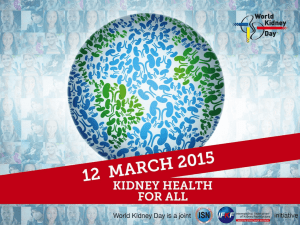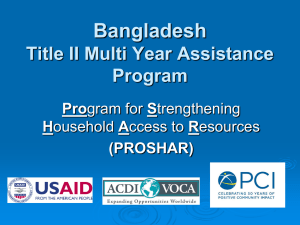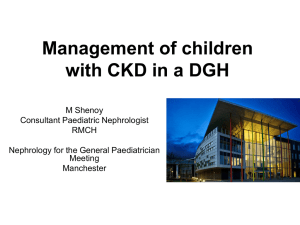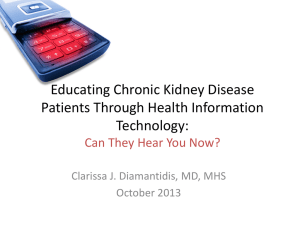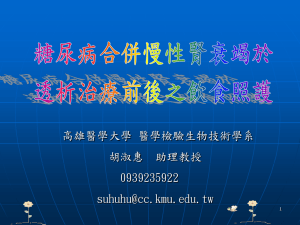Protein Energy Wasting (PEW)
advertisement
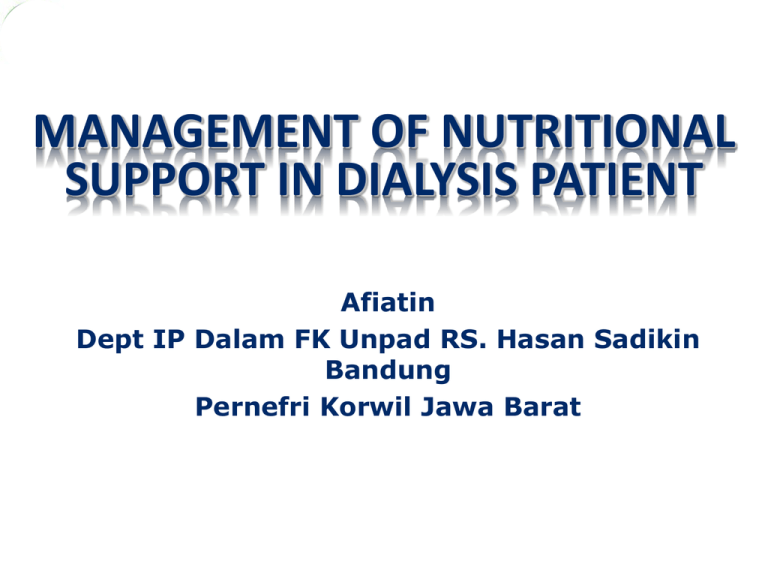
MANAGEMENT OF NUTRITIONAL SUPPORT IN DIALYSIS PATIENT Afiatin Dept IP Dalam FK Unpad RS. Hasan Sadikin Bandung Pernefri Korwil Jawa Barat What is PEW? • Protein Energy Wasting is the state of decreased body store of protein and energy fuels. • In CKD, the conditions result in loss of lean body mass not only related to reduced nutrients intake but also included nonspecific inflammatory process. MALNUTRITION Overnutrition OBESITY Undernutrition MALNUTRITION Macronutrient Malnutrition Protein Malnutrition (kwashiorkor) Micronutrient Malnutrition Energy Malnutrition (marasmus) Protein - Energy Malnutrition / Protein Energy Wasting CKD Stages & Protein-Energy Malnutrition/Wasting ESRD GFR Stage 1 Stage 2 Kidney Damage With Normal or Kidney Function Kidney Damage With Mild Kidney Function 130 90 Stage 3 Moderate Kidney Function 60 Stage 5 Stage 4 Severe Kidney Function 30 Kidney Failure 15 0 Prevalence U.S. 3.1% 4.1% 7.6% 0.5% China 5.7% 3.4% 1.6% 0.13% Malnutrition (PEW in U.S.) 28%–48% Normal Appetite Anorexia PEW: Protein-Energy Wasting (uremic malnutrition) 1. 2. 3. 4. 5. USRDS 2009 Annual Data Report; Stratton JD et al. J Ren Nutr 2003; 13: 191-198; Fouque, Kalantar-Zadeh, Kopple et al. Kidney Int 2008;73: 391-398 Kovesdy et al, AJCN 2009 Zhang et al, Lancet 2012. Up to 75% Prevalence of PEW • These are stable dialysis patients, the real prevalence would be even higher. • The prevalence in both PD and HD patients seems equally. Study Year Country Data collection Sample size Age Method Prevalence de Mutsert et al. 2009 Netherlands 1997-2000 1601 HD 59 SGA 28% Cordeiro et al. 2009 Sweden 2003-2004 173 HD 65(51-74) SGA 43% Rambod et al. 2009 USA 2001-2006 809 HD 5315 MIS>5 46.8% Miyamoto et al. 2011 Sweden 2000-2008 280 HD 5315 SGA 30.3% Vasselai et al 2008 Brazil Not stated 45 PD 515 SGA 35.6% Chung et al. 2009 Korea 1994-2000 213 PD 513 SGA 40.4% Wang et al. 2009 China 1999-2001 244 PD 512 SGA 44.3% Szeto et al. 2010 China 2006-2007 314 PD 12 MIS>6 SGA 60.2% 28.7% Leinig et al. 2011 Brazil 2001-2008 199 PD 513 SGA 64.7% Pernefri korwil Jabar 2012 Juli – Desember 2012 264 HD MIS >6 40,7 % Indonesia Jawa Barat Lama HD : 1 – 192 bulan Protein Energy Wasting (PEW) • Decreased body stores of protein and energy fuels, including body protein and fat masses Undernutrition Inadequate diet, anorexia Wasting/Catabolism Inflammation: cytokines & adipokines Metabolic acidosis, reduced anabolic drive, insulin resistance, dialysis, sedentary lifestyle The Mechanism of PEW Chronic Kidney Disease Anorexia Inflammation Insulin resistance Weakness & Fatigue Weight loss Annual weight loss > 5% or BMI < 20 Kg/m2 Anemia Muscle Wasting Fat loss • Hypogonadism Reduced muscle strength, VO2 max & physical activity Cachexia 3 of 5 • • • • Muscle strength decreased• Abnormal lab data - increased CRP, IL-6 Fatigue - Anemia (Hb < 12 g/dL) anorexia - low albumin( <3.2 g/dL) Low fat-free mass index Robert et al., J Cachexia Sarcopenia Muscle, 2011;2:9-25 Protein-Energy Wasting Syndrome The conceptual model of etiology and consequences of PEW in CKD Ikizler et al, Kideny Int 2013; May: 1-12 Mortality and BMI in 54,535 hemodialysis patients 2.2 Highest Mortality Relative Risk of All-Cause Death 2 Unadjusted Case-mix* 1.8 Case-mix & MICS ** 1.6 1.4 Overweight 1.2 Obese Morbidly Obese 1 0.8 Underweight Normal BMI 0.6 0.4 <18 18-19.99 20-21.49 21.522.99 23-24.49 25-27.49 27.529.99 30-34.99 35-39.99 40-44.99 >=45 Body Mass Index (kg/m2) Kalantar-Zadeh et al, AJKD 2005, & Kidney Int 2003 (& multiple other publications) 1.00 Near Infra-Red body fat measurement in 535 Hemodialysis Patients 24-36% 0.98 >36% 0.94 0.96 12-24% 0.92 Lowest Body Fat Worse Survival 0.88 0.90 2.5 year survival follow-up in 535 MHD Patients 0 100 200 300 nir12g = 1 Kalantar-Zadeh et al, Am J Clin Nutr 2006 400 <12% 500 600 700 cohort days nir12g = 2 800 nir12g = 3 900 1000 1100 nir12g = 4 Mid-Arm Muscle Circumference -.5 DEATH (Log hazard ratio) 0 .5 1 and 5-Year Mortality (2001-06) in 792 hemodialysis patients 0 20 40 60 MAMC percentile 80 100 Noori et al, CJASN 2010 Therapeutic Strategies for Prevention/Treatment of PEW in CKD on dialysis Nutritional supplementation Appetite stimulation Acidosis correction Inflammation/hormone modulation Exercise & physical activity Dialysis Modified from: Robert et al., J Cachexia Sarcopenia Muscle, 2011;2:9-25 Goals of CKD Management Achieve/maintain optimal nutritional status Prevent protein energy wasting Prevention/treatment of complications and other medical conditions – DM – HTN – Dyslipidemias and CVD – Anemia – Metabolic acidosis – Secondary hyperparathyroidism Proposed Algorithm for Nutritional Management and Support in CKD patients Clinical diagnosis of PEW On hemodialysis treatment : Negative protein balance is occurred • independently to protein intake • And caused by : • amino acids loosing through dialyzer membrane • protein catabolism increasing due to glucose loosing through dialyzer membrane Nutrients loosing during hemodialysis treatment Substance Amino Acids Gram /hour dialysis 2.0 Protein / Peptide < 0.2 Glucose 8.0 Vitamins +++ PERITONEAL DIALYSIS • Amino acids loosing through peritoneal membrane : 5 – 15 gram/day • • Glucose absorption from dialysate :100 – 200 gram/day Vitamine and mineral loosing Estimation of dialysate energy absorption • Energy absorption : 60-70% • Amount : – 1.5% / 2L solution = 78 Kcal – 2.5% / 2L solution = 130 Kcal – 4.25% / 2L solution = 221 Kcal * Heimburger O, Waniewski J, Werynski A, Lindholm B. A quantitative description of solute and fluid transport during peritoneal dialysis. Kidney Int 1992; 41:13201332 Nutritional Requirements of CKD Stg 5 with dialysis (NKF KDOQI) Nutrients Recommended intakes per day Peritoneal Dialysis Energy Protein Hemodialysis 35 Kcal/ kg IBW - <60 yrs 30-35Kcal/ kg IBW - ≥60 yrs 1.2-1.3g/kg IBW/ day(=50% of High Biological Value). Some nitrogen balance studies indicate that protein intake of ≥ 1.0 g/ kg IBW may be enough. Fats 1.2-1.3g/kg IBW/ day(=50% of High Biological Value). Some nitrogen balance studies indicate that protein intake of ≥ 1.0 g/ kg IBW may be enough. 30% of total energy supply Water and sodium As per residual diuresis 750 – 1000 ml + diuresis Potassium 40-80mmol. Individualized depending on serum levels 2-3 gr/d Calcium Individualized, usually not <1000mg/ day 1000 mg/d Phosphorous 8-17 mg/ kg or 800-1000 mg/ day (adjusted to higher protein needs), when serum phosphorous is > 5.5 mg/ dl² 800 – 1200 mg/d ¹Carrero JJ, Heimburger O, Chan M, Axelsson J, Stenvinkel P and Lindholm B. Protein energy malnutrition/ wasting during peritoneal dialysis. In: Nolph and Gokal’s textbook of Peritoneal Dialysis. Krediet RT, Khanna R, eds. 3rd Edn. NY: Springer, 2009: 611-647. ²National Kidney Foundation. K/DOQI clinical practice guidelines for managing bone metabolism in chronic kidney disease. Am J Kidney Dis2003; 42(suppl 1):S1-S92 FLOW OF NUTRITIONAL SUPPORT PROCESS IDENTIFICATION POPULATION AT RISK (CHRONIC DISEASE) SCREENING YES YES NO ASSESSMENT NO DIAGNOSIS AND INTERVENTION MONITORING AND EVALUATION (MONEV) SCREENING TOOL FOR DIALYSIS PATIENTS • MALNUTRITION INFLAMMATION SCORE • • • • SGA : + Dialysis aspects PHYSICAL EXAMS BODY MASS INDEX LABORATORY PARAMETERS MIS : > 6 MALNUTRITION NUTRITIONAL INTERVENTION/SUPPORT IS NEEDED STEPS DIETARY RECALL DIETARY PLAN Don’t make a plan without knowing the real problem TREATMENT MONITORING EVALUATION NUTRITIONIST IS A MUST IN THE TEAM NUTRITIONAL MONITORING AND EVALUATION • Make a schedule to evaluate the nutritional support • Evaluate by the tools • Interval : 2 weekly or monthly NUTRITIONIST IS A MUST IN THE TEAM Nutrition Support in CKD No Total Parenteral Nutrition (TPN) Functional GIT Yes Enteral Nutrition (EN) HDx 1st Tube feeding (TF) Oral (+edn & counseling): +/- • Food fortification • Oral nutrition supplementations (ONS) +/PDx Intra- Peritoneal Nutrition MO: • Control co-morbidities/ inflammation • Medications / Appetite stimulant Intradialytic PN (IDPN) Nursing Exercise training Multi-disciplinary Approach Psychosocial support Nutritional Therapy / Nutritional Support Enteral • Oral Nutrition Support • Meals during dialysis treatment • Tube feeding Parenteral • IDPN (intra-dialytic parenteral nutrition) • TPN Pharmacologic • Appetite stimulators • Anti-Depressant • Anti-inflammatory • Anabolic &/or muscle enhancing Kalantar-Zadeh … Ikizler, Nature Nephrology 2011 Oral Nutrition Support Diet counseling (+ prescription & meal plan) (1) Food ± (2) ± Food enriching/ fortifications (3) Oral Nutrition Supplements Characteristic/ strategy • Use energy & nutrient dense foods & drinks • adding protein, fat & CHO to foods and drinks, e.g. egg, cheese, milk, milk powder sugars, fats • commercial modules e.g. protein powder, tasteless sugars • Ready –made formula & desserts • protein & energy bar Advantage • economical • familiar items: • taste • texture • cultural specific • economical • familiar items: • taste • texture • cultural specific • easy to use • convenient • easy handling (in institutions) staff and hygiene Limitation “larger” volume “larger” volume • cost • acceptance • taste • possible intolerance EXAMPLE 2 Mrs C, 42 year old, CKD stg 5 on chronic hemodialysis Problem : she has gastropathy ec NSAID , she feel epigastric pain when taking her meal Height : 152 cm, 40 kg (Ideal BMI : 22--IBW 50.82 kg), Her dry weight continue to decrease , 2 kgs in a month weeks, No diarrhea She feels fatique, she took days off 2-3 time a week (she is a teacher ) HD 2 times a week MIS 12 Need nutritional support STEPS DIETARY RECALL DIETARY PLAN Don’t make a plan without knowing the real problem TREATMENT MONITORING EVALUATION NUTRITIONIST IS A MUST IN THE TEAM EXAMPLE Mrs C, 40 year old, CKD stg 5 on chronic HD, 40 kg Height: 152 BMI :17.39 Ideal Body Weight : 50.82 kg (BMI 22) ENERGYNUTRIENTS Requirements Mrs C requirement Energy 35 kcal/kg IBW/d 30 kcal/kgIBW/d(>60 yrs) Or to attain IBW 1400 kcal/d Protein 1.2 g/kg IBW/d 48 g/d Sodium(mmol/d) 80-100 80-100 Potassium (mmol/d) 70 70 Phosphorus (mg/d) <1000 1000 Fluid (ml/d)) Urine Output + 500 1000 ml Mrs C daily intake recall BREAKFAST 1 bowl of cereal 1 cup of tea with 2 tsp sugar 2 biscuits LUNCH 1 cup of soft steam rice ½ bowl of chicken broth Vegetable 1 cup 1 cup of tea 2 tsp sugar DINNER Milk 150 ml 1 cup of noodle soup Juice 100 ml EXAMPLE Mrs C, 40 year old, CKD stg 3 on chronic HD, 40 kg ENERGY NUTRIENTS Energy Mrs C requirement 1400 kcal/d Mrs C actual intake 800 kcal/d Protein 48 g/d 20 g/d Sodium(mmol/d) 80-100 120 Potassium (mmol/d) 70 <70 Phosphorus (mg/d) 1000 500 Fluid (ml/d)) 1000 ml 1100 ml Meeting : 57.1 % of estimated energy and 41.6 % protein requirements Unbalanced and inadequate intake of the core food groups Need nutritional support - repletion Nutrition Support in CKD No Total Parenteral Nutrition (TPN) Functional GIT Yes Enteral Nutrition (EN) HDx 1st Tube feeding (TF) Oral (+edn & counseling): +/- • Food fortification • Oral nutrition supplementations (ONS) +/PDx Intra- Peritoneal Nutrition MO: • Control co-morbidities/ inflammation • Medications / Appetite stimulant Intradialytic PN (IDPN) Nursing Exercise training Multi-disciplinary Approach Psychosocial support NEPHRISOL KANDUNGAN Unit Per saji (61 g) ENERGI kkal 260 g 6 SFA g 2 MUFA g 2 PUFA G 2 G 39 Laktosa g 0 PROTEIN g 13 LEMAK/FAT KARBOHIDRAT g 7.43 LEUCIN g 1.43 ISOLEUCIN g 1.06 VALIN g 0.99 TRIPTOFAN g 0.19 FENILALANIN g 0.79 METIONIN g 0.81 TREONIN g 0.73 LISIN g 1 HISTIDIN g 0.43 ASAM AMINO ESENSIAL ASAM AMINO NON ESENSIAL 5.14 ARGININ g 0.41 ASPARTAT g 0.90 GLUTAMAT g 2.22 SERIN g 0.53 GLISIN g 0.17 ALANIN g 0.56 TIROSIN g 0.35 TOTAL ASAM AMINO 12.57 RASIO ASAM AMINO AAE 60 NAAE 40 VITAMIN Vitamin A % 15 Vitamin D3 % 6 Vitamin E % 10 Vitamin C % 10 Vitamin B1 % 25 Vitamin B2 % 25 Vitamin B6 % 30 Vitamin B12 % 10 Asam Folat % 15 Asam Pantotenat % 15 MINERAL Kalsium % 20 Fosfor % 10 Magnesium % 8 Seng % 15 Selenium % 15 Natrium % 3 Kalium % 2 Mrs C daily menu BREAKFAST LUNCH DINNER 1 bowl of chicken porridge 1 egg schootel 1 cup of tea with 2 tsp sugar 1 cup of soft steam rice 1 bowl of sauted beef and vegetable 100 ml fresh apple juice Nephrisol D 1 serving 1 steam tofu and vegetable 10 am : Nephrisol D 1 serving 260 kcal prot 13 g 4 pm : Nephrisol D 1 serving 260 kcal prot 13 g As pudding 2 biscuits THE CALORIES INCREASE GRADUALLY TO MEET THE NEED FOR THE IDEAL BODY WEIGHT (50 KG = 1500 Kcal/day) My patient • Mr Nanang, 43 years old • CKD Stage 5 ec glomerupathy on chronic HD (4 years) • His appetite was decreased , no infection, no GI complaint, HD was adequate. His dry BW decrease 2 kgs in 3 weeks. • He started to increase his daily intake by consume Nephrisol D , and he is taking 3 box (9 servings) a week • His dry weight was increased 3 kgs in a month Mr. Nanang FAILURE WITH ORAL NUTRITION SUPPORT INTRADIALYTIC PARENTERAL NUTRITION Complimentary if ONS only meet : 20 kcal/kg/day and protein intake < 0,8 gr/kg/day


